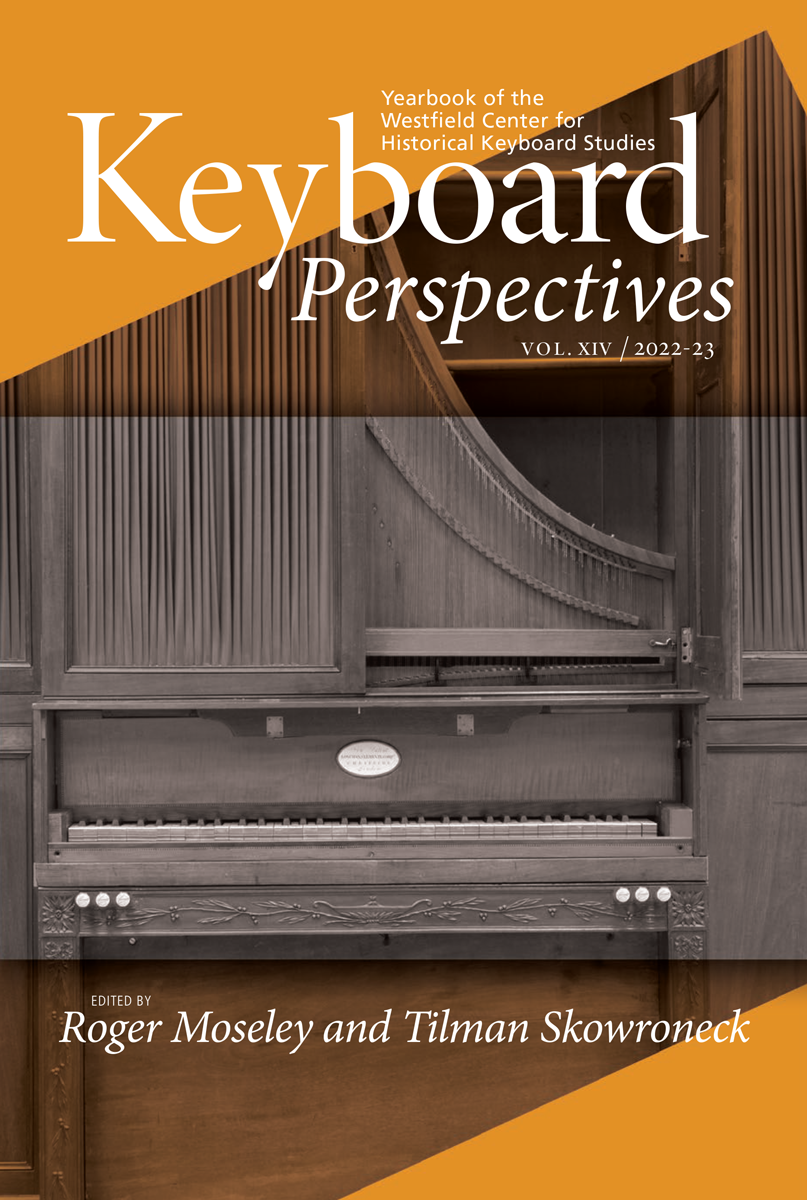Keyboard Perspectives XIV (2022–23)
Founding Editor: Annette Richards
Editors-in-chief: Roger Moseley and Tilman Skowroneck
Copyeditor: Ed Crooks

|
Andrew Willis
Anne Laver
Matthew Bengtson
Jacob Fuhrman
Elly M. Langford
John R. Watson
Shaena B. Weitz
Tilman Skowroneck |
Preface
This fourteenth volume of Keyboard Perspectives contains articles derived from presentations and performances given at an extended celebration of the fortieth anniversary of the Westfield Center for Historical Keyboard Studies. In October 2019, more than seventy members (not to mention a host of other interested participants and observers) converged on Oberlin, Ohio, for a conference titled “Blending Past and Present: Collections and Collectors.” There, they enjoyed four days packed full of papers, roundtable discussions, performances, and masterclasses. The all-star lineup of scholars, performers, and instrument builders was brought together by a committee led by Kathryn Stuart, who was then Westfield’s Executive Director and who organized proceedings with limitless energy and consummate skill. The event was universally held to be a resounding success.
None of those who gathered at Oberlin Conservatory, where the Frederick R. Selch Collection of American Music History offered attendees fascinating encounters with instruments from its 700-strong holdings, could have known that the COVID-19 pandemic lay around the corner, and that “Blending Past and Present” would be the last event of its kind for years to come. The effects of the pandemic also played a part in the long delay (even by academic standards) between the conference and the publication of the articles it engendered, and we apologize for the wait that subscribers have endured. We nonetheless hope that the eclectic selection of essays herein will evoke pleasant memories of those October days for those who were there and will provide entertainment and edification for all.
The opening article by Andrew Willis focuses on Beethoven’s Polonaise op. 89 (1814), a piece that—after a free introduction and a rather conventional statement of the main rondo theme—evolves into ever less predictable episodes. Willis provides a quick-paced and performance-oriented analysis of this piece, which tends to “deliver a loosely defined, illogical, and spur-of-the-moment experience that had much in common with the spontaneity of improvisation.” For those familiar with Beethoven’s work, this concept is reminiscent of the Fantasy op. 77, in which, in Willis’s words, “the performative context appears unplanned, capricious, and unstable, as in a truly improvised free fantasia.” However, as in the Fantasy, the unpredictable elements in the Polonaise are “part of a process in which every step has a purpose.” This leads to questions of how to perform the turns and quirks of the piece. Willis advises against an impulse to soften the harshness or “to round it off and make […] beautiful” what was supposed to sound abrupt and shocking. “A performer today can dance with [Beethoven] along a winding path, chuckle with him at his own cleverness, and enjoy the applause his ingenuity has ensured.”
Anne Laver’s article considers the important role played by French organist Alexandre Guilmant in fostering interest in music by composers such as Buxtehude, Frescobaldi, and de Grigny in the USA at the turn at the twentieth century. Guilmant edited dozens of volumes of early music for Durand in Paris, and his protégé William C. Carl later published selections from them in Boston in The Historical Organ Collection. While Guilmant’s and Carl’s efforts as both editors and performers might be subject to criticism from latter-day perspectives, they flesh out the stakes of early music appreciation in North America at a crucial juncture by laying out an alternative both to the modernist belief in technological and aesthetic progress and to the unbroken continuation of nineteenth-century tradition.
Matt Bengtson’s lecture-recital at the “Blending Past and Present” conference was inspired by two unique keyboard instruments in the Selch Collection: a split-key Italian virginal after Poggi by Owen Daly (2016) and a Broadwood parlor grand piano (ca. 1865). Bengtson here brings together repertoires from seventeenth-century Naples and from the French Romantic pianist Charles- Valentin Alkan. This juxtaposition finds its common denominator in keyboard instruments that “struggle to find a satisfactory tuning, and a fascination with the enharmonic phenomena that arise from the effort.”
Bengtson’s approach leans toward the practical, or “a composer’s tactile and imaginative connection to an instrument, the nature of creative response, and our own reenactment of that process through touch and sound.” Beginning with the problem of matching expanding tonalities to the system of quarter-comma meantone temperament, Bengtson explains the solution of creating keyboard instruments with varying amounts of sub-divided semitones, designed to accommodate enharmonic pitches. Admittedly, the introduction of subsemitones mostly catered to accompanists who had to transpose on their soloists’ behalves, and so the solo repertoire for various kinds of chromatic keyboards is rather restricted. Yet Bengtson is able to demonstrate the Neapolitan enharmonic “stravaganze” style in a number of examples by Mayone, Trabaci, and others.
Moving to Charles-Valentin Alkan and his “intrepid sense of pianistic adventure …, bizarre sounds and unique resonances,” Bengtson shows how the use of a period instrument can unlock some of the riddles of this music and makes it possible for the player to convey Alkan’s textures with greater clarity where, on a modern piano, they risk sounding like failed experiments. Tying the two parts of this article together, Bengtson ends with a reflection on Alkan’s piece “Les enharmoniques,” from Esquisses op. 63, no. 41.
For his part, Jacob Fuhrman examines the intriguing evidence of debates concerning the optimal way for Dutch keyboardists to accompany the Genevan Psalter across the eighteenth century. Fuhrman shows that reading ostensibly humble accompaniment books by Conrad Friedrich Hurlebusch and others can shed light on arguments and practices relating to text-setting, declamation, harmony, aesthetics, and theology while also enabling us to identify distinct readerships, audiences, and spaces ranging from the amateur to the professional and the domestic to the ecclesiastical.
Elly Langford then leads us into the fascinating world of early modern combination keyboards, which include claviorgans, vis-à-vis keyboards, and instruments that hybridize different types of action. Beyond the technological interest such instruments hold for modern observers, particularly insofar as they might be thought to anticipate later developments, Langford encourages us to pay attention to the contexts in which they first resided (typically seventeenth-century Wunderkammern, or “curiosity cabinets”) and the cultural prestige such unusual instruments would have conferred on their owners.
John Watson addresses the complex topic of instrument restoration by exploring ways of maintaining historical substance without having to compromise on playability. Watson’s focal point is the wealth of information that is preserved in old surfaces. Such information can often only be found when there is an actual question to pursue—when someone is looking, for example, for the reason that lies behind a tool trace. Watson here introduces the concept of restorative conservation, which he characterizes as “restoring an instrument with equal emphasis on restoring musical function and preserving historical evidence.” The object of his demonstration is an organized upright grand piano made by Longman, Clementi & Co. in 1799. Watson walks the reader through a substantial number of decisions and technical solutions for bringing this instrument, whose piano action was missing and whose pipes were badly damaged, back to life. As is typical of Watson’s thoughtful approach, he states that “the treatments described above could conceivably fall short by future standards,” and ends with his own critical but collegial assessment of a restoration of another instrument that took place in 1970.
The volume is rounded out by two reviews. First, Shaena Weitz applauds Four Hands for France, a collection of lesser-known nineteenth-century works performed on an 1853 Érard by Stephanie McCallum and Erin Helyard to exhilarating and poignant effect. And finally, Keyboard Perspectives co-editor Tilman Skowroneck reviews David Breitman’s important new book Piano-Playing Revisited: What Modern Players Can Learn from Period Instruments, which is surely destined to open the eyes and ears of pianists everywhere.
— Roger Moseley and Tilman Skowroneck
